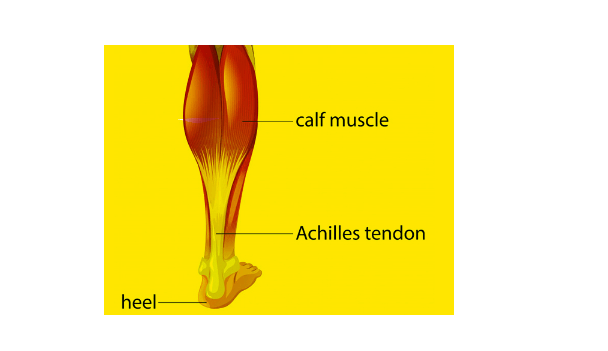Quick Overview
The Achilles tendon is the largest and strongest tendon in the human body. It connects the calf muscles (gastrocnemius and soleus muscles) to the heel bone (calcaneus bone). It is responsible for plantar flexion of the foot, which is the movement of pointing the toes down.
The Achilles tendon is essential for walking, running, and jumping. It also helps to stabilize the ankle and provide power to the push-off phase of gait.

Table of Contents
Achilles Tendon Anatomy
It is a thick band of tissue that is about 6 inches long. It is located on the back of the lower leg, just above the heel. The tendon is surrounded by a sheath of connective tissue called the paratenon. The paratenon provides a blood supply to the tendon and helps to protect it from injury.
Achilles Tendon Rupture
It is a relatively rare injury, but it can be very disabling. Achilles tendon ruptures most commonly occur in athletes who participate in sports that involve running, jumping, and sudden stops and starts.
Symptoms of rupture include:
- A sudden, sharp pain in the back of the leg
- A popping or snapping sound
- Difficulty walking or running
- Swelling and bruising in the back of the leg
Treatment option typically involves surgery to repair the tendon. In some cases, nonsurgical treatment may be possible, but it is important to see a doctor to discuss the best treatment options for your individual case.
Read also Adductor Tendons and Supraspinatus Tendon
Achilles Tendonitis
It is the inflammation of the tendon, and more common injury than a rupture. This can be caused by overuse, such as from running or jumping. It can also be caused by a direct blow to the back of the leg.
Causes
The most commonly cause is overuse of the tendon. This can occur from activities such as running, jumping, and hill climbing. Other possible causes include;
- Wearing shoes that do not fit properly
- Having a tight calf muscle
- Being over the age of 40
Signs and Symptoms
The most common symptom is pain in the back of the leg, just above the heel. The pain is typically worse during activity and may improve with rest. Other symptoms include:
- Swelling and tenderness in the back of the leg
- Crepitus (a popping or grinding sensation) in the back of the leg
- Stiffness in the ankle
- Difficulty walking or running
Diagnosis
Diagnosis is based on a physical examination and medical history. Imaging tests, such as an ultrasound or MRI, may be ordered to confirm the diagnosis and assess the severity of the injury.
Treatment
Treatment is typically conservative and includes rest, ice, compression, and elevation (RICE). Physical therapy may also be recommended to help strengthen the calf muscles and reduce inflammation. In some cases, nonsteroidal anti-inflammatory drugs (NSAIDs) or corticosteroid injections may be prescribed to help reduce pain and inflammation.
Prevention
The best way to prevent this condition is to avoid overuse of the Achilles tendon. This can be done by gradually increasing the intensity and duration of your workouts, and by wearing shoes that fit properly. Other things you can do to help prevent Achilles tendonitis include:
- Stretching your calf muscles regularly
- Warming up before exercise
- Cooling down after exercise
- Maintaining a healthy weight
Questions
Q: How long does it take to recover from an Achilles tendon rupture?
The recovery time for an Achilles tendon rupture varies depending on the severity of the injury and the individual’s healing process. Most people recover within 6 months to a year, but some people may take longer.
Q: What are the risks of Achilles tendon surgery?
The risks of Achilles tendon surgery include infection, bleeding, nerve damage, and wound healing problems. In rare cases, the tendon may rupture again after surgery.
Q: What can I do to prevent Achilles tendonitis?
To help prevent Achilles tendonitis, you can:
1- Gradually increase the intensity and duration of your workouts.
2- Wear shoes that fit properly and provide good support.
3- Stretch your calf muscles regularly.
4- Warm up before exercise and cool down afterwards.
5- Maintain a healthy weight.
Q: What is the best way to treat Achilles tendonitis?
The best way to treat Achilles tendonitis depends on the severity of the injury. In most cases, treatment includes rest, ice, compression, and elevation (RICE). Physical therapy may also be recommended to help strengthen the calf muscles and reduce inflammation. In some cases, nonsteroidal anti-inflammatory drugs (NSAIDs) or corticosteroid injections may be prescribed to help reduce pain and inflammation.
Q: What are the long-term complications of Achilles tendonitis?
Long-term complications of Achilles tendonitis include:
1- Chronic pain
2- Weakness in the calf muscle
3- Stiffness in the ankle
4- Recurrence of tendonitis
5- Achilles tendon rupture
